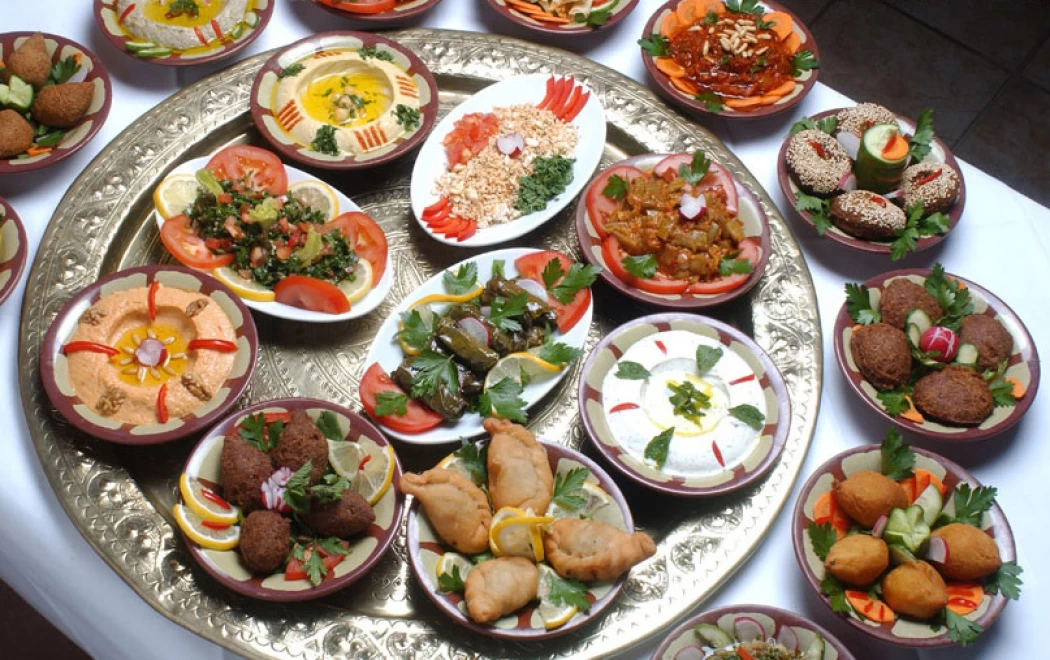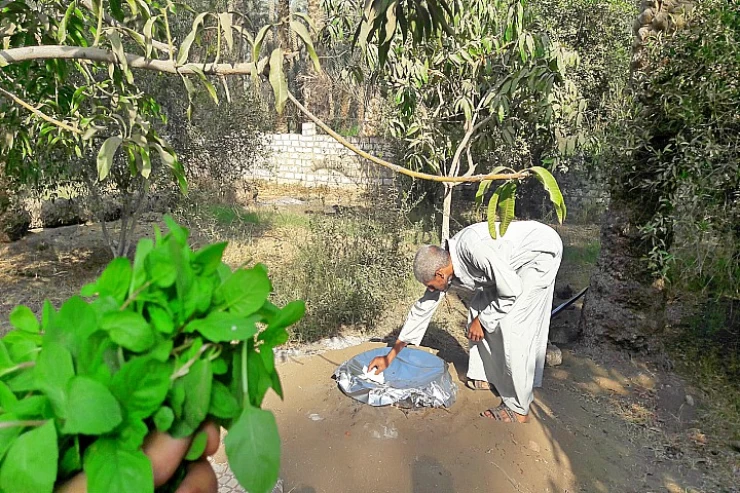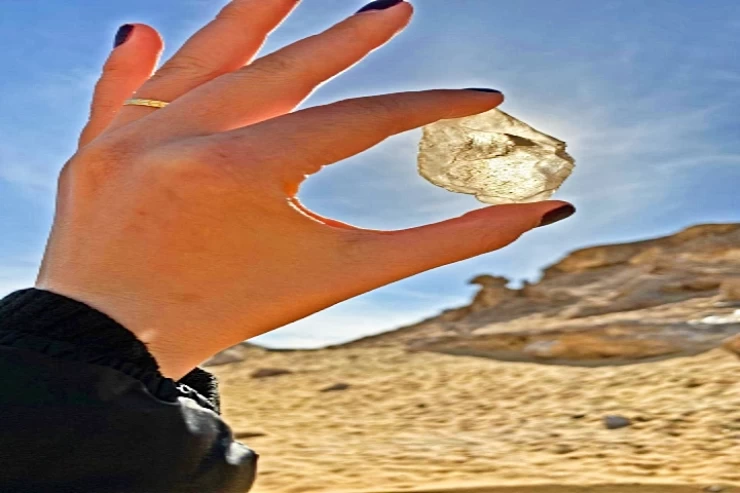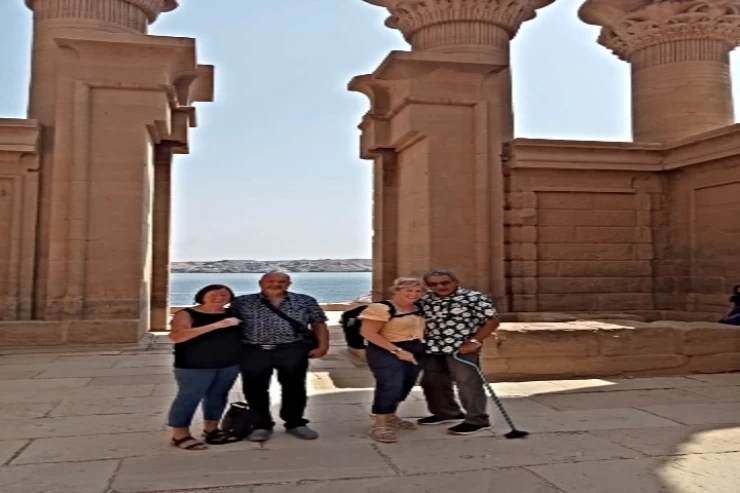
Cucina egiziana
La cucina egizia
Fa un uso massiccio di legumi la Cucina egiziana , verdure e frutta provenienti dalla ricca Valle del Nilo e dal Delta dell'Egitto. Condivide somiglianze con il cibo della regione del Mediterraneo orientale, come verdure ripiene di riso, foglie di vite, shawarma, kebab e kofta. Esempi di ricette egiziane includono ful medames che sono purè di fave; kushari, lenticchie e pasta; e molokhia, stufato di gombo.
Il pane pita, noto localmente come eish Baladi, e la produzione di formaggio in Egitto risalgono alla prima dinastia egizia, con il formaggio feta il tipo più comune di formaggio consumato oggi.
Dall'Egitto il primo paese agricolo del mondo, quindi il piatto più sano del mondo è la cucina egiziana, il tuo pasto include proteine, vetgetable, carboidrati, vitamine e ferro, quindi il piatto è un pasto sano completo
Le carni comuni nella cucina egiziana sono conigli, piccioni, pollo e anatre. L'agnello e il manzo vengono solitamente utilizzati per le grigliate. Il falafel è uno dei famosi fast food del Cairo e le torte dolci preparate nella regione da almeno 2500 anni. Oltre al pesce e ai frutti di mare comuni nelle zone costiere dell'Egitto, il più famoso di loro è la città di Alessandria. C'è una grande quantità di cibo vegetariano egiziano, sia per il prezzo relativamente alto della carne che per le esigenze della comunità cristiana copta, le cui restrizioni religiose richiedono essenzialmente diete vegetariane per la maggior parte dell'anno.
La bevanda del tè è la bevanda nazionale dell'Egitto, dove gli egiziani hanno imparato in molti modi a preparare il tè dove puoi bere ovunque in un bar locale forse durante i tuoi tour a piedi al Cairo al caffè Al Fishawy, e il caffè è il secondo, la birra è la più bevanda alcolica popolare. Mentre l'alcol è un tabù religioso e musulmani e copti impegnati tendono a evitare le bevande alcoliche, l'alcol è prontamente disponibile nel paese.
I dolci popolari in Egitto includono baklava, sebousah, konafa e swabe 'zeinab. Gli ingredienti comuni nei dessert includono datteri, miele e mandorle.
La cucina egiziana è particolarmente propensa ai pasti vegetariani perché fa molto affidamento su fagioli e piatti vegetariani. Anche se il cibo ad Alessandria e nelle città costiere dell'Egitto tende a utilizzare una grande quantità di pesce e altri frutti di mare, la cucina egiziana differisce da un governatorato all'altro ma per la maggior parte dipende dai cibi che crescono fuori dalla terra.
I porti egiziani del Mar Rosso sono stati il primo punto di ingresso principale per le spezie dall'Europa, poiché varie spezie erano facilmente accessibili nel corso degli anni e queste spezie hanno lasciato il segno nella cucina egiziana, come il cumino, che è considerato una delle spezie più utilizzate. Altre spezie comuni includono coriandolo, peperoncino, pepe nero, anice, alloro, aneto, zenzero, cannella, menta e chiodi di garofano.
Tra le carni comuni trovate nella cucina egiziana ci sono conigli, piccioni, pollame e anatre. Viene spesso bollito per preparare il brodo per varie zuppe e zuppe. L'agnello e il manzo sono le carni più comuni utilizzate nel barbecue. Le carni alla griglia come il kofta (kofta), il kebab (kebab) e le fette grigliate vengono chiamate in modo intermittente il barbecue.
È popolare in Egitto, nelle viscere degli animali e in varie carni. Il fegato ei panini specializzati ad Alessandria sono tra i fast food più famosi del paese. Pezzi di fegato tritati fritti con peperone dolce, peperoncino, aglio, cumino e altre spezie vengono serviti in un pane tipo baguette chiamato eish fino. Mangia anche cervelli di mucche e pecore in alcune città dell'Egitto.
Cucina e pratica religiosa:
Uno dei mesi che godono di molte attività è il mese del Ramadan, che è il mese di digiuno per i musulmani in Egitto, ma di solito è il momento in cui gli egiziani sono caratterizzati da molta preparazione del cibo dopo la colazione, prestando attenzione a la diversità del cibo e la sua ricchezza, perché l'iftar è un affare di famiglia, e intere famiglie spesso si incontrano sulla tavola, esattamente dopo il tramonto, dopo la preghiera del Maghrib. Ci sono molti dessert che vengono serviti quasi esclusivamente durante il Ramadan, come Kunafa (Kanafe) e Qatayef (Qatayef). Questo mese, molti egiziani preparano un tavolo speciale per i poveri o gli astanti, di solito in una tenda per strada, chiamato Teaching Assistant of the Most Merciful (arabo egiziano: Rahman's Table, che letteralmente si traduce in "Schedule of Mercy", riferendosi a uno dei 99 nomi di Dio, questo può essere un po 'semplice o un po' lussuoso, a seconda della ricchezza e delle capacità del suo creatore.
I cristiani osservanti in Egitto aderiscono a periodi di digiuno secondo il calendario copto; questi possono praticamente estendersi a più di due terzi dell'anno per i più estremi e attenti. La popolazione copta più laica digiuna principalmente solo per Pasqua e Natale. La dieta copta per il digiuno è essenzialmente vegana. Durante questo digiuno, i copti di solito mangiano verdure e legumi fritti nell'olio ed evitano carne, pollo e latticini, inclusi burro e panna.
Le bevande:
Il tè è una parte importante della vita quotidiana e del folclore in Egitto. Di solito è accompagnato da una visita familiare a un'altra persona, guardando il livello dell'economia sociale o lo scopo della visita, su una tazza di tè obbligatorio. L'ospitalità può essere necessaria per te stesso. Il nome comune per il tè in Egitto è "dovere" (pronunciato in arabo come "wa-jeb" o "wa-geb"), dato che servire il tè a un visitatore è un compito, mentre qualsiasi altra cosa è bella.
Caffè, qahwa egiziano arabo: è considerato una parte dell'accoglienza tradizionale in Egitto. Di solito è preparato in una piccola caffettiera, che in Egitto si chiama dalla. Viene servito in una tazzina da caffè chiamata fengan. Il caffè viene solitamente addolcito con zucchero a vari gradi; 'Al riha, mazbout e ziyada più sariaose rispettivamente. Il caffè non zuccherato è noto come sada, o normale.
In Egitto, il succo di canna da zucchero è chiamato "aseer asab ed è una bevanda incredibilmente popolare servita da quasi tutti i venditori di succhi di frutta, che si possono trovare in abbondanza nella maggior parte delle città dell'Egitto
Tè alla liquirizia e bevande a base di succo di carruba sono tradizionalmente gustati durante il mese islamico del Ramadan, così come l'amar al-din, una bevanda densa prodotta ricostituendo fogli di albicocca secca con acqua. Le lenzuola stesse vengono spesso consumate come caramelle. e la Sobia è un'altra bevanda tradizionalmente servita durante il Ramadan. È una bevanda dolce al latte di cocco, solitamente venduta dai venditori ambulanti. Una bevanda acida e fredda a base di tamarindo è popolare durante l'estate chiamata tamr hindi. Si traduce letteralmente in "Indian Dates", che è il nome arabo del tamarindo.
Il nostro team vi aiuterà a viaggiare in Egitto e sperimentare il tempo soleggiato del nostro bel paese durante la Pasqua, grazie alla loro vasta conoscenza del turismo egiziano. Puoi personalizzare il tuo pacchetto selezionando uno dei nostri pacchetti di viaggio in Egitto o sfruttare al massimo il tuo tempo in una breve visita, imparando di più sulla storia egiziana e le sue affascinanti storie e vivendola attraverso tour privati al Cairo. Partecipa a uno dei nostri tour economici in Egitto attraverso il deserto del Sahara, come i tour di Siwa dal Cairo, per esempio, o preferibilmente i tour nel Deserto Bianco d'Egitto. Scoprite i nostri tour di un giorno ad Assuan, fate una gita di un giorno da Assuan ad Abu Simbel, o viaggiate via terra e godetevi i nostri tour di un giorno a Luxor per vedere gli incredibili templi di Karnak, il Tempio di Luxor, il Tempio di Hatshepsut, e vedete le meravigliose tombe splendidamente dipinte nella Valle dei Re, questo è il luogo dove i re e i governanti del nuovo regno riposano in pace e imparate i loro riti di mummificazione e sepoltura. Il nostro specialista in egittologia vi fornirà ampie informazioni sulla Storia dell'Egitto o sui siti storici.
Culinary Expeditions in Egyptian Food: History and Gastronomy in One Buffet
Each nation has its specialties and recipes that draw from time, culture, geography, and so on, and Egypt is not an anomaly in that order. Egyptian food culture has existed and flourished for thousands of years, and their culinary practices may constitute the simplest of natural ingredients, but they have always been rich and flavorful. Whether swirling through the street markets of Cairo, having seemed more exotic than any empire’s cuisine while dining by the Nile, or tucking into the home-cooked food of relatives in a village in Egypt, one finds the thrill of finding new and exciting combinations of flavors and cuisines in the Egyptian culinary experience, which is also home to wondrous sights.
We can begin from the very first Egyptian bread ovens installed by the Pharaohs and come to the kitchens of today. This only goes to show that Egyptian food is very traditional but at the same time takes in a lot from Italy, the Middle East, Africa, and other places. Now let’s get ready for exploration—culinary exploration to be more exact—and examine the unique features, typical cuisine, and role of eating in Egypt.
A Historical Feast: The Origins of Egyptian Cuisine
The history of food in Egypt dates back to the Pharaoh's time. This is because ancient Egyptians played a great role in agriculture, growing wheat, barley, vegetables, and fruits along the banks of the Nile, which was very fertile. The making of bread was integral to the people, and learning to bake bread is among the oldest culinary practices in Egypt. On tomb paintings and hieroglyphs, images of an intact banquet consisting of bread, fish, meat, fruits, and beer are illustrated, which indicates the significance of food in ancient Egypt.
Throughout the ages, Egypt’s culinary art has changed due to many factors over the centuries. For instance, the Greeks, the Romans, and many other civilizations including the Ottomans and Arabs had a role in these changes. Each civilization made contributions in one way or another, bringing along new herbs, cooking methods, and food elements that fused with the ethnic culture of the region to give rise to the effective and delicious cuisine that we have nowadays.
The cuisine of Egypt is characterized by the use of uncomplicated and healthy ingredients, most of which are produced in Egypt itself. Here are some of the main elements that are central to the practice of cooking in Egypt:
Fava beans (ful): Fava beans are one of the most popular ingredients in Egypt, featuring in full, another traditional dish in which fava beans are stewed, and taameya, or Egyptian falafel.
Bread (Aish Baladi): In every Egyptian meal, there is bread included. The most familiar is called aish baladi, which is a circular flatbread made from whole wheat flour slightly thicker than pita and used extensively. It is used to scoop food, wrap around food, and with many other dishes.
Rice: In Egyptian culture, rice is often served as a side dish and is usually exceptional to dishes like gumbo, grilled dishes, or loaded up with other ingredients and spices.
Lentils: The lentil pulse is popular and often used in many Egyptian plates; for example, these include soups, stews, and kosher.
Herbs and spices: One of the main reasons is that most of the food is also full of warm and earthly favors. So, fresh herbs like cilantro, parsley, dill, and spices like cumin, garlic, cinnamon, and turmeric are often added in cooking.
Molokhia: Another quintessential favorite from Egypt is molokhia, which is derived from a green leafy plant with a warm and gooey texture served as a garlicky soup and eaten with rice or bread.
Within Egypt's extensive history, there exists an array of Egyptian dishes that are quite distinct from one another. Thick hearty stews, deep-fried street snacks, and sugary desserts that provide warmth—there is something for everyone. Below are some of the primary dishes that typify the Egyptian food culture:
1. Ful Medames: The National Dish of Egypt
Ful medames, or farinaceous porridge, as it is better known, is a delicious, rich food consisting of seasoned, slow-cooked fava beans with olive oil, lemon, garlic, and cumin. Normally it is taken for breakfast with additional healthy foods such as fresh bread and eggs and some other vegetables like tomato, onion, and cucumber. Being Egyptian national food, it is highly appreciated by residents, and clearly for the tourists, it is a must-dish. This uncomplicated and delicious it has been part of culinary history for many generations, even from Pharaoh’s reign.
2. Taameya: Egyptian Falafel
Globally referred to as felafel, the taameya is the Egyptian equivalent of this popular street food. Unique to the Egyptian version of taameya is the use of fava beans instead of chickpeas to prepare also lighter, airier, and fluffier balls than the rest. Light, crispy, and deep-fried golden brown fritters flavored with herbs—coriander and parsley—would usually be sandwiched in between tahini, salad, and pickles. Taameya can be eaten as a snack or consumed as a meal, and it will prove hard to resist for anyone who tries it.
3. Koshari: The King of Street Food
The most popular street food in Egypt is kosher. Meaning “a mixture,” comfort comes naturally wherever this staple meal type exists. Koshari consists of rice, lentils, macaroni, and chickpeas, which are further topped with a delicious tangy tomato sauce as well as crunchy fried onions and spicy garlic vinegar. Due to its filling properties and inexpensive price, this carbohydrate-rich food entices every Egyptian citizen across all strata. Although kosher boasts simple and cheap ingredients, the dish is a complex jumble of flavor and texture and is highly seasoned.
4. Molokhia: A Green, Garlicky Delight
One of the first food experiences that leaves visitors to Egypt oftentimes unprepared is the strangely tasty and textured dish called Molokhia. The dish consists of cooked mookhia leaves (which are the jute leaves), blended with garlic and coriander to make an edible green paste. This dish is often served together with rice or a dish called aish baladi (Egyptian bread) and is sometimes eaten with chicken, rabbit, or beef. The slimy feel of the dish may take some getting used to, but it is a treasured dish among the Egyptians because of the comfort it brings along with the flavor of the dish, which is not normalized.
5. Mahshi: stuffed vegetables
Mahshi is a common term for toppings stuffed into vegetables such as zucchinis, peppers, or grape leaves that contain rice, spices, and sometimes meat. The stuffing is the center of having tomatoes, onions, and all the spices, which results in the rich and interesting taste of the dish. Mahshi is often cooked on holidays and parties due to the time and effort invested in cooking it. This dish consists of tender soft vegetables in every bite filled with aromatic rice, making it a perfect yummy comfort food back home in Egypt.
6. Fattah: A Festive Feast
Fatet, located in the middle of the plate, is a celebratory platter put together only on rare occasions, such as wedding parties or religious festivities. It consists of crisp, deep-fried bread pieces, rice, and stewed meat, all drenched in vinegar and garlic sauce. The way of serving and eating changes as the dish is filled with broth, resulting in a sumptuous and rich dish that fills one's stomach. In Egyptian traditions, Fattah connotes plenty and refreshment and is thus served and savored on occasions such as feasts and family get-togethers.
7. Hawawshi: Egyptian Meat Pie
Ful medames is a popular street food in Egypt made from boiled fava beans seasoned with olive oil, salt, and cumin. Hawawshi can be considered the Egyptian version of a meat pie. Ground, spiced, and cooked meat, often combined with vegetables and will almost always contain herbs, is present in a pocket of pita bread and oven-baked. The end product is a very sumptuous, tasty, and moist filling beautifully enveloped in a crisp crust. Hawawshi is well-loved by many as a street bite and is ideal for snacking in a hurry or for a quick lunch.
And no exploration of Egyptian gastronomy would be seen as if without having a taste out of its sweetest part. Egyptian sweets are heavy and rich, loaded with nuts, honey, and spices. Below are some of the famous confections found in the native country:
Basbousa: Syrup cake garnished with either almond or coconut. In Egypt, this sweet, moist cake is symbolic of festivities, and it is served in almost all functions.
Konafa: Pestilious stuffing of nuts, cream, or cheese, prohibitively sweetened and layered in a cake made of a very thin chick pastry rolled into slippery threads. In many Arabic countries, konafa is served during the holy month of Ramadan and other feasts.
Om Ali: Egyptian pudding made of layers of marinated and baked phyllo dough and milk with nuts, raisins, and spices. This rich and hearty dessert is usually prepared during festive occasions like family gatherings and cultural events.
Shai is among the beverages that are most enjoyed in various aspects of life in Egypt, more so in gatherings. It is typical for the Egyptians to consume tea without milk, sweetened with sugar, or flavored with a bit of mint. In the case of many Egyptians, tea is not just another drink but an intricate cultural aspect because it represents hospitality and relaxation, especially after a heavy meal or while engaged in social activities with friends. In addition to tea, Karkadeh, which can be referred to as hibiscus tea in English, is another beverage well appreciated in Egypt characterized by its unbelievable red color and a tasty sourness.


















